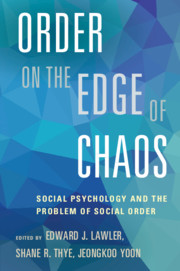Book contents
- Frontmatter
- Contents
- List of Contributors
- Preface
- 1 Social Psychology of Social Order: An Introduction
- 2 The Evolutionary Biology and Sociology of Social Order
- 3 Social Rationality and Weak Solidarity: A Coevolutionary Approach to Social Order
- 4 An Integrative Theory of Action: The Model of Frame Selection
- 5 The Center Cannot Hold: Networks, Echo Chambers, and Polarization
- 6 Social Exchange and Social Order: An Affect Theory Approach
- 7 Institutions, Trust, and Social Order
- 8 Identity Verifi cation and the Social Order
- 9 Identities, Roles, and Social Institutions: An Affect Control Account of Social Order
- 10 The Gender Frame and Social Order
- 11 Status, Power, and Social Order
- 12 Interaction Order: The Making of Social Facts
- 13 The Arts of Together: Social Coordination as Dyadic Achievement
- 14 Dignity as Moral Motivation: The Problem of Social Order Writ Small
- 15 The Legitimacy of Groups and the Mobilization of Resources
- Commentary: Contrasts and Complementarities
- Index
- References
13 - The Arts of Together: Social Coordination as Dyadic Achievement
Published online by Cambridge University Press: 05 December 2015
- Frontmatter
- Contents
- List of Contributors
- Preface
- 1 Social Psychology of Social Order: An Introduction
- 2 The Evolutionary Biology and Sociology of Social Order
- 3 Social Rationality and Weak Solidarity: A Coevolutionary Approach to Social Order
- 4 An Integrative Theory of Action: The Model of Frame Selection
- 5 The Center Cannot Hold: Networks, Echo Chambers, and Polarization
- 6 Social Exchange and Social Order: An Affect Theory Approach
- 7 Institutions, Trust, and Social Order
- 8 Identity Verifi cation and the Social Order
- 9 Identities, Roles, and Social Institutions: An Affect Control Account of Social Order
- 10 The Gender Frame and Social Order
- 11 Status, Power, and Social Order
- 12 Interaction Order: The Making of Social Facts
- 13 The Arts of Together: Social Coordination as Dyadic Achievement
- 14 Dignity as Moral Motivation: The Problem of Social Order Writ Small
- 15 The Legitimacy of Groups and the Mobilization of Resources
- Commentary: Contrasts and Complementarities
- Index
- References
Summary
Abstract
Coordination is the micro-foundation of social order. Smooth interaction requires individuals to attend and respond to one another within the flow of action, each individual continually calibrating actions to correspond to others. While this is taken for granted, the processes by which this occurs warrants examination. We apply philosophical theories of collective intentionality that specify the conditions necessary for two or more people to intend to act together to a sociological analysis of how individuals coordinate action. We treat the dyad as the most basic and prototypical group, examining dyadic encounters across three different social activities: walking together, engaging in sexual intercourse, and making music. We analyze the interplay of verbal and nonverbal communication, caution and risk, and scripted action and spontaneity, that underlies social coordination. Order implies a metaphor of rigidity and control, but social order, a product of interpersonal coordination, requires flexibility and adaptation, ranging from the minutest bodily movements to meta-understandings of local meaning.
When people are acting together, doing whatever it is – crossing a street, running a factory, making dinner, playing a gig – they have to arrive at a way of doing that together, getting their specific activities to mesh in some way so that they can get something done, maybe not what they intended but something. How do they do that? Well, they can rely on things they already know (the canon or some version thereof) or they can make it all up from scratch (free jazz, maybe?), or who knows what in between.
Howard Becker (Becker and Faulkner 2013)How do dyads coordinate action to achieve a goal? How is joint action possible? This is a problem of fitting together lines of action (Blumer 1969). We address Becker's discussion of social coordination, how people act together, illustrating the “who knows what” that lies between scripted routines and spontaneous reactions.
Social acts from the most basic, such as walking together, to the more complex, such as playing music, require collaboration that develops from social relations and shared histories. To understand this we treat the dyad as the most basic and most prototypical group (Bratman 1992:327), recognizing structural differences between dyads and larger groups (Simmel 1902–1903). Building on theories of collective intentionality in philosophy and group culture theory in sociology, we argue that smooth coordination is central to social order.
- Type
- Chapter
- Information
- Order on the Edge of ChaosSocial Psychology and the Problem of Social Order, pp. 248 - 267Publisher: Cambridge University PressPrint publication year: 2015
References
- 4
- Cited by



